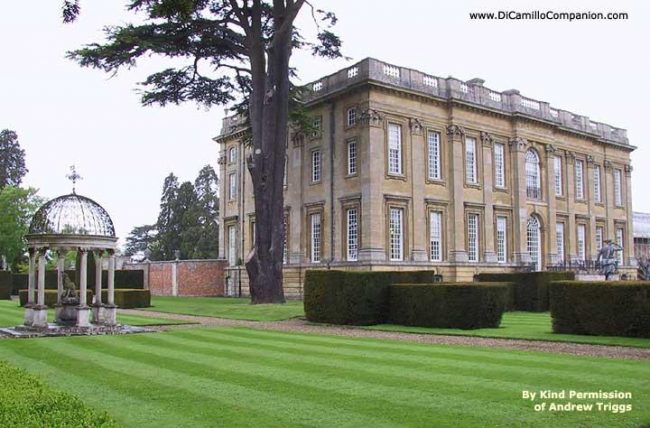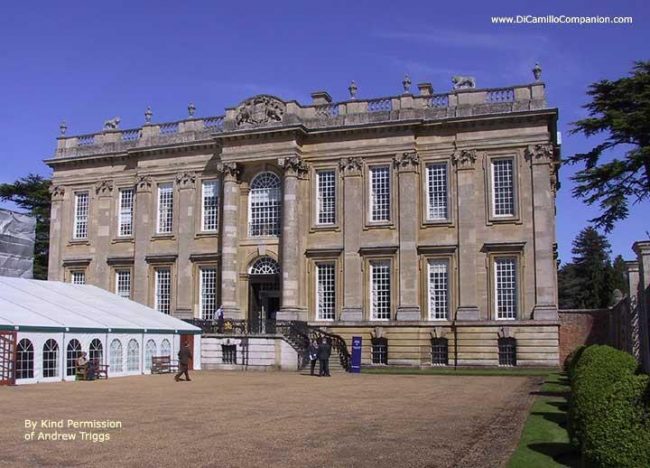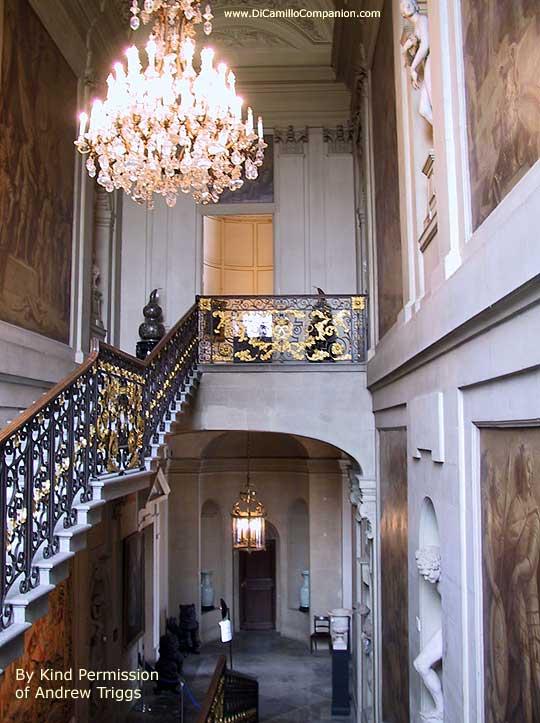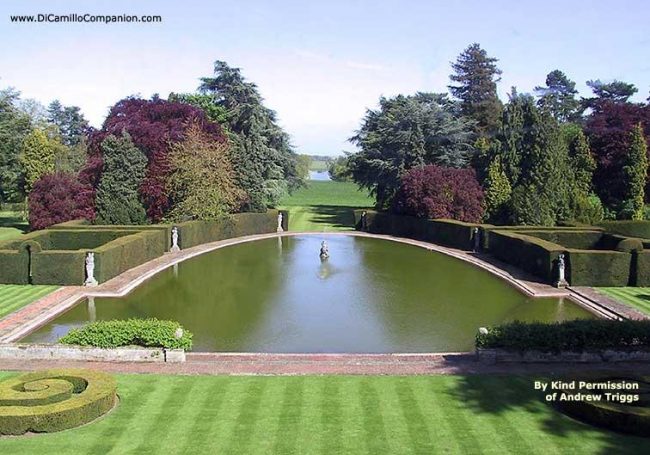
The garden facade

The entrance facade

The staircase

The garden
Earlier Houses: An earlier house was demolished to make way for the current house.
Built / Designed For: Sir William Fermor, 1st Lord Leominster
House & Family History: Since the Middle Ages the Fermors were a landed family; first in Oxfordshire and then in Northamptonshire. Sir Richard Empson was Henry VII's treasurer; he was executed for treason by Henry VIII in 1510, after which, little by little, the Empson Estate, centered in the village of Easton Neston, came into the hands of the Fermor family. By the 1530s Richard Fermor, a wealthy merchant, owned the majority of the estate. When the Fermors acquired Easton Neston the original house stood south of the Medieval church; this was greatly expanded and became large enough to host visits by Elizabeth I, Anne of Denmark, and Prince Charles (later Charles I). Nothing today survives from the original house, save the Wheel of Life (which sold at the 2005 auction of the contents of Easton Neston for £14,400, against a high estimate of £7,000). In 1692 Sir William Fermor (1647-1711, three times great grandson of Richard Fermor) was elevated to the peerage as the 1st Baron Leominster. It was the new Lord Leominster who, in the mid-1690s, commissioned Nicholas Hawksmoor to design the new (current) house. Hawksmoor created a masterpiece that is one of Europe's most beautiful and grand Baroque buildings, a house of extraordinary originality and sophistication executed by craftsmen of the highest order. The main fabric of the house was completed in 1702 (the date that appears on the pediment of the east facade; the pediment of the west facade contains the 1st Lord Leominster's coat of arms). The Great Hall was designed specifically to accommodate the Arundel Marbles, acquired by Lord Leominster in 1691 from the 7th Duke of Norfolk (more of the Arundel Marbles were scattered throughout the gardens). This famous collection of ancient Roman statues, collected by the 21st Earl of Arundel in the first half of the 17th century, was matched by the equally important Mortlake tapestries, commissioned by George Villiers, 1st Duke of Buckingham, and purchased by Leominster circa 1672 (the Tapestry Room was specifically designed by Hawksmoor to display the Mortlake tapestries). The Great Hall was further decorated with wall paintings of "The History of Cyrus" by Sir James Thornhill, painter to the king, who was working concurrently on the ceiling of Wren's St. Paul's Cathedral. The dining room, with its ebullient plasterwork, is attributed to Charles Stanley, the Danish stuccoist and sculptor who worked in England from 1727 to 1740. Easton Neston was very likely originally conceived by Christopher Wren for the 1st Lord Leominster, who was Wren's kinsman. For most of its history the house, as seen today, was believed to be the work of Nicholas Hawksmoor (Hawksmoor was one of Wren's apprentices and Easton Neston is the only country house believed to have been designed by Hawksmoor). However, research in 2005 by Charles Hind, curator at the RIBA, suggested that Easton Neston may have been originally been designed by the famously difficult William Talman and later executed (with exterior alterations) by Hawksmoor. This re-evaluation (supported by Giles Worsley and David Watkin) was prompted by the purchase (for £180,000) by the RIBA of the original model for the house, which revealed plans that bear the hallmark of Talman's work. The west façade of Easton Neston displays gilt lettering of the family motto: "Hora e Sempre" ("Now and Always"). Lord Leominster's eldest son, Thomas Fermor (1698-1753), was created the 1st Earl of Pomfret in 1721, after which numerous court appointments followed, including master of the horse to Queen Caroline, ranger and keeper of St. James's Park, and governor of Jersey. The earl's eldest son, George Fermor (1722-85), was a bad seed and a notorious spendthrift; as a result, the earl left only the entailed estate to his son; his other assets, including his magnificent art collection, were left to his two unmarried daughters. After the earl's death the pictures were sold in London in March 1758. The Arundel Marbles were acquired privately by Lady Pomfret from her daughters and were presented to the University of Oxford in 1755 (today in the Ashmolean Museum). George, 5th Earl of Pomfret (1824-67), had a younger brother, The Hon. Thomas Fermor (1832-64), who entered the army and served in Egypt, where his pioneering work as a photographer recorded some of the first recorded photographs of its monuments. Thomas died early, like his brother the 5th Earl, which meant that the male Fermor line came to an end in the mid-19th century. Sir Thomas George Fermor-Hesketh, 7th Bt., who visited Japan in 1880 on his yacht, the "Lancashire Witch," began the important collection of Asian art at Easton Neston. Sir Thomas also sailed his yacht to San Francisco, where he captured the heart of Florence Emily Sharon, daughter of Senator William Sharon, one of the two richest men in the American West. When they married in 1885, Florence was the richest American heiress to marry an Englishman in the late 19th century. After they settled down at Easton Neston, the couple discovered that they were of very different temperaments; Lady Fermor-Hesketh was fond of society, while her husband preferred being on his own. In the workshop behind the stableblock Sir Thomas designed and built the first motorcar made in England. It seems fitting, therefore, that his descendant, Thomas Alexander Fermor-Hesketh, 3rd Baron Hesketh (born 1950), became a noted motor racing enthusiast. Lord Hesketh founded Hesketh Racing in 1972, which competed in Formula One from 1973 to 1978. After Hesketh Racing was shut down Lord Hesketh founded Hesketh Motorcycles PLC in an attempt to revive the British motorcycle industry. In 1982 the motorcycle company built a new factory in Daventry, Northamptonshire, specifically to manufacture the Hesketh V1000 motorcycle. The motorbikes were plagued with numerous problems from the beginning, including the overheating of the rear cylinder (due to lack of air flow). The manufacture of the unreliable motorcycle was discontinued after the production of 149 bikes and the company went into receivership in August 1982. Lord Hesketh formed a new company in 1983 called Hesleydon Ltd. to manufacture an improved V1000. Called the Vampire, the new iteration inherited too many of the V1000's faults and only 40 motorcycles were produced before the company closed in 1984. In the late 20th century Lord Hesketh removed Victorian additions and thus restored the house to Hawksmoor's designs. The north wing was badly damaged by fire in July 2002 was restored. In May 2004 the entire 3,319-acre Easton Neston Estate was put up for sale for £50 million. The sale as one lot did not occur and the estate was sold off in smaller lots, with 2,270 acres of farmland, some houses in the village of Hulcote, and Pomfret Lodge (Grade II) going for approximately £20 million. The house, together with two lodges, the stableblock, and 550 acres of parkland was sold in July 2005 for just under £15 million to Leon Max, a Russian-born American businessman, who lives in the house and uses the north wing and stables as the European headquarters of his company, Max Studio. Max Studio employs approximately 30 staff at Easton Neston and uses the Georgian stableblock as a call center for its mail-order business. Max, who was born in St. Petersburg, defected to the USA in the mid-1970s and started the California-based Max Studio retail chain. Mr. Max, in the early 21st century, engaged the famous interior designer Henrietta Spencer-Churchill to decorate the interiors of Easton Neston.
Collections: Brian Fairfax's "A Description of Easton Neston," published in 1758, mentions that the great chimneypiece in the saloon is by William Kent (Lord Pomfret met Kent in Italy in 1718-19 while on his first Grand Tour). Fairfax goes on to state that the picture collection at Easton Neston included works by Rottenhammer, Titian, Guido Reni, van de Velde, Chiari, Roestraten, Salvatore Rosa, and Maratta (the pictures were sold in London in March of 1758). A large portion of the famous Arundel collection of antique marbles was at Easton Neston until the mid-18th century. The Arundel Marbles were acquired privately by Lady Pomfret from her daughters and were presented to the University of Oxford in 1755 (today in the Ashmolean Museum). William Hogarth's "Two Children Playing at Easton Neston" was donated to the National Museum of Wales in 1988 in lieu of tax. Gerard David's "The Virgin Feeding the Child from a Bowl of Soup" was sold to a foreign party at Christie's on July 8, 1988 for £748,000. Also at the July 8 Christie's sale Carlo Crivelli's "Madonna and Child" was sold to a private party for £550,000 and Michele Marieschi's "View of the Church of the Salute, Venice" sold for £550,000. Jan Brueghel II's "Archduke Albert and Archduchess Isabella Clara Eugenia in the Park at Brussels" was sold to a private party at Christie's on May 24, 1991. Books and manuscripts from the Fermor-Hesketh library at Easton Neston were sold at auction by Sotheby's on December 15, 1999 and raised £1,376,771. On May 17-19, 2005 over a quarter of the entire Hesketh collection was auctioned off by Sotheby's; the sale raised £8,727,964—the second-highest sum from a country house contents sale to date. Included in the sale was the famous model of Easton Neston by Hawksmoor, which sold for £176,000 to the Royal Institute of British Architects (it is on view in the RIBA Gallery at the Victoria & Albert Museum, London) and the Pomfret Cabinet, made for Henrietta Louis, Countess of Pomfret, circa 1755 (probably by William Hallet). The cabinet was originally part of the collection of Pomfret Castle, London, and migrated to Easton Neston when Pomfret Castle was demolished in 1934; it sold for £108,000. The Rothschild Rock Crystal Chandelier, a huge mid-19th century Louis XV style lighting fixture, sold for £102,000, against a high estimate of £80,000. Three lots of furniture from Marchmont, Scottish Borders, were sold during the great Easton Neston Sotheby's sale. But certainly the star of the 2005 sale was Lord Wenlok's Tankard, an English bronze jug of the late 14th or early 15th century. The jug is cast with three shields bearing the arms of Edward III and sold for £568,000, against a high estimate of £80,000.
Garden & Outbuildings: George, 3rd Earl of Pomfret (1768-1830), acquired, in 1820, land near Watling Street, south of Towcester; here he commissioned John Raffield to build a triumphal entrance gate and screen to the park, complete with decorative fixtures in Coade stone. The Empress Elisabeth of Austria, a regular visitor to Northamptonshire during the 1870s and 1880s, hunted with the Grafton, Pytchley, and other local packs. In 1876 the empress leased Easton Neston for the season (a bedroom named after her commemorates her stay). The Towcester Racecourse was inaugurated especially for her entertainment, with the first race meeting being held on Easter Monday 1876. The race proved such a success that one was held every year thereafter. At the time of the 2005 sale of the house Lord Hesketh decided to retain the Towcester Racecourse. In September 2008 the racecourse was put up for sale for £10 million.
Architect: William Talman
Date: 1695-1702Architect: John Raffield
Date: 1822-23Architect: William Kent
Date: Ante 1735Architect: Nicholas Hawksmoor
Date: 1695-1702Vitruvius Britannicus: C. I, pls. 98-100, 1715.
Country Life: XXIV, 630, 666, 1908. LXII, 262, 296 plan, 1927. CXLVIII, 968, 1970.
Title: Lost London: A Century of Demolition and Decay
Author: Hobhouse, Hermione
Year Published: 1979
Reference: pg. 31
Publisher: London: Macmillan
ISBN: 333198263
Book Type: Softback
Title: Sotheby's Auction Catalog: Easton Neston, May 17-19, 2005, Volume Two
Author: NA
Year Published: 2005
Reference: pg. 315
Publisher: London: Sotheby's
ISBN: NA
Book Type: Softback
Title: Sotheby's Auction Catalog: Easton Neston, May 17-19, 2005, Volume One
Author: NA
Year Published: 2005
Reference: pgs. 13-16, 18-23, 26-27, 158, 280
Publisher: London: Sotheby's
ISBN: NA
Book Type: Softback
Title: Treasure Houses of Britain, The - SOFTBACK
Author: Jackson-Stops, Gervase (Editor)
Year Published: 1985
Reference: pg. 659
Publisher: Washington, DC: National Gallery of Art (New Haven: Yale University Press)
ISBN: 0300035530
Book Type: Softback
Title: Biographical Dictionary of British Architects, 1600-1840, A - HARDBACK
Author: Colvin, Howard
Year Published: 2008
Reference: pgs. 498, 617, 841
Publisher: New Haven: Yale University Press
ISBN: 9780300125085
Book Type: Hardback
Title: Architectural Digest: The International Magazine of Fine Interior Design
Author: NA
Year Published: NA
Reference: Jan 2003, pg. 107
Publisher: New York: The Conde Nast Publications
ISBN: NA
Book Type: Magazine
Title: Disintegration of a Heritage: Country Houses and their Collections, 1979-1992, The
Author: Sayer, Michael
Year Published: 1993
Publisher: Norfolk: Michael Russell (Publishing)
ISBN: 0859551970
Book Type: Hardback
Title: Country Life: 100 Favourite Houses
Author: Green, Candida Lycett
Year Published: 1999
Publisher: London: Boxtree
ISBN: 0752213334
Book Type: Hardback
House Listed: Grade I
Park Listed: Grade II*
Current Seat / Home of: Leon Max
Past Seat / Home of: SEATED AT CURRENT HOUSE: Sir William Fermor, 2nd Bt. and 1st Lord Leominster, 17th-early 18th centuries; Thomas Fermor, 1st Earl of Pomfret, 18th century; Sir Thomas George Fermor-Hesketh, 7th Bt., late 19th-early 20th centuries; Thomas Alexander Fermor-Hesketh, 3rd Baron Hesketh, 20th century.
Current Ownership Type: Individual / Family Trust
Primary Current Ownership Use: Private Home
House Open to Public: No
Historic Houses Member: No